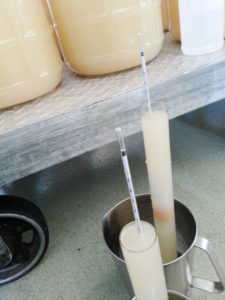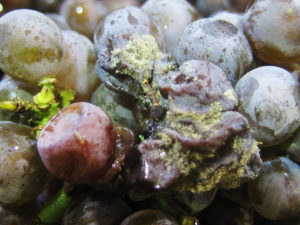Sometimes, a stuck fermentation is inevitable despite a winemaker’s best efforts to avoid it. Stuck fermentations are defined as periods of time during primary fermentation when sugar conversion unexpectedly slows down or stops completely (Iland et al. 2007).

Photo by: Denise M. Gardner
Maybe the wine takes off aggressively before the winemaker is able to gain control of the fermentation. Perhaps daily readings get lost in the harvest shuffle. Or maybe, the wine just got stuck due to a lack of specific nutrients that winemakers do not typically measure.
If you’ve dealt with stuck fermentations in the past and want solutions on resolving them, the September Darn Good Winemakers webinar will focus on how to “unstick” a stuck fermentation. In the presentation titled: Re-Starting a Stuck Fermentation we’ll review:
- Monitoring methods to track your fermentation easily.
- Simple steps for re-starting a stuck fermentation.
- Yeast and enological product recommendations I keep on hand each harvest season just in case a stuck fermentation occurs.
Following the webinar, I’ll be available for a live session to answer any winemaking questions Darn Good Winemakers members may need advice on.
You can join our winemakers’ network at any time! Joining the Darn Good Winemakers provides you with:
- 12 webinar invitations (one per month),
- Webinar reminders,
- Written material specific for the webinars,
- Live coaching sessions to ask Denise your winemaking questions (without paying a consulting fee),
- Access to past webinars, and
- Exclusive email content sent solely to the network.
Today, however, let’s discuss why stuck fermentations may occur.
Presence of Inhibiting Agents
There are a number of constituents and chemicals that can alter the course of any primary fermentation. Let’s review a few of the most common:
Fermentation Parameters: Ethanol, Temperature, and Oxygen
One of the most obvious inhibitors is ethanol itself. While wine yeasts’ primary goal is to convert the available sugar into ethanol, as the ethanol accumulates, the surrounding environment becomes more toxic for the yeast to survive. Saccharomyces yeast, the yeast used to ferment wine and many other alcoholic beverages, cannot typically ferment past 17% ethanol concentrations.
As ethanol accumulates, it gets more and more difficult for remaining yeast cells to feed off the remainder of available sugar, metabolize, and produce more ethanol. With this in mind, high alcohol musts can often pose difficulty for many wine yeasts to complete the fermentation.
Yeast growth and survival is also subjected to temperature. Like many living organisms, yeast strains have optimal temperature ranges in which they can grow and metabolize. If using a commercial yeast strain, these optimal temperature ranges can be easily referenced in your supplier handbook. Going below or above the optimal temperature ranges can cause yeast death, and obviously halt the fermentation.
Wine yeasts are aerobic microorganisms, meaning they require oxygen to survive, grow, and function. Ensuring ferments get properly aerated during primary fermentation is essential to support yeast metabolism.
Lack of Proper [Yeast] Nutrition
One primary element required by yeasts to metabolize is nitrogen. Because nitrogen is such an essential component of primary fermentation, we’ll cover yeast available nitrogen (YAN) and how to manipulate it in the next blog post. Stay tuned for more info on this!
However, other important constituents (i.e., thiamin, biotin, and many minerals) have been identified that support yeast growth. While some of their roles in yeast growth and function during fermentation are well-known, there are not many specific winemaking recommendations pertaining to each individual nutrient.
However, thiamin additions are regulated by the TTB and addition rate limitations can be found in the CFR. Furthermore, it’s important to note that many freeze-dried yeast cultures contain many of these additional nutrients as part of their formula (Jones 2018).
Chemical Inhibitors
Additional constituents brought in on grapes (e.g., pesticide residues) or created during primary fermentation (e.g., medium-chained fatty acids) can lead to primary fermentation complications. Some of these constituents may directly interfere with yeast metabolism and others may alter yeast physiology that can limit yeast functionality.
While these problems can be difficult to identify, it is possible they can contribute towards stuck or sluggish ferments. Furthermore, Schmidt et al. (2012) found the presence or absence of some minerals can lead to noticeable aromatic and flavor differences of a wine. Some inhibitors may also lead to wine off-flavor development (e.g., sulfur-based pesticide residue has been previously linked to hydrogen sulfide development).
Rot Byproducts

Photo by: Denise M. Gardner
Along the lines of chemical inhibitors, some chemical constituents that develop due to the presence of certain rots can also lead to more frequent stuck fermentations. Winemakers should remember to treat fruit/juice/must appropriately and specifically based on the rot. Some treatments, like sulfur dioxide additions, may reduce microbial rot presence. Other treatments, such as adding beta-glucanase enzymes to grape juice, reduce the presence of some rot byproducts.
If sulfur dioxide is added to juice produced from rotted grapes, make sure to measure the juice pH. If the free sulfur dioxide concentration gets too high for a given juice pH, it can inhibit primary fermentation. To better understand sulfur dioxide’s inhibition on microbial activity, please refer to the previous Darn Good Winemakers session, Demystifying Sulfur Dioxide.
Microbial Competition
Depending on the yeast selection, and also when using native ferments, competition from other microorganisms in the fermenting must can lead to a sluggish or stuck fermentation.
Some processes, (e.g., grape transport, cold soaks, native ferments) can support native microorganisms’ growth and activity. Microorganisms that grow during these processes may not necessarily be Saccharomyces yeast or desirable for wine quality. This rise in microbial populations can ultimately affect competition for nutritional resources in the must (i.e., nitrogen, vitamins, minerals, essential amino acids). In fact, native yeast and bacteria populations have been shown to deplete nutrients essential for yeast growth and metabolism within three hours of contact with grapes or must (Jones 2018).
Some winemakers have found scanning juice and must under a microscope prior to fermentation helpful. This can provide an indicator of potential microbial competitors or latent spoilage after primary fermentation is complete.
Tricky Wine Styles
Some wine styles are going to be more prone to stuck fermentations. Good examples of these include late harvest wines, ice wines, and cyroextracted wines. In these three styles, the elevated sugar content can lead to osmotic stress. Osmotic shock describes conditions in which the sugar concentration surrounding the cell leads to a change of water ingress into the cell (Wikipedia). If too much osmotic stress exists for the yeast cells, the yeast can actually die (Jones 2018).
Furthermore, starting with elevated sugar concentrations may not be conducive for creating dry wine styles in general. This means that at some point the fermentation may simply stick. In most instances, yeast fermentation sticks when alcohol concentrations get too high for the yeast to continue growing in combination with osmotic challenges or nutrient depletion associated with these styles of wine.
How to Unstick a Stuck Fermentation
There are a lot of possible scenarios that can lead to a stuck fermentation. However, re-starting a stuck fermentation can also be a lot of work.
Do you feel insecure about re-starting a stuck fermentation? Join the Darn Good Winemakers network today and join us for our September webinar titled Re-Starting a Stuck Fermentation. Not only will your membership registration grant you access to our September session, but you’ll be enrolled for the next 11 webinars!
References
Iland, P., P. Grbin, M. Grinbergs, L. Schmidtke, and A. Soden. (2007.) Microbiological Analysis of Grapes and Wine: Techniques and Concepts. ISBN: 978-0-9581605-4-4.
Jones, M. (January 2018.) Avoiding Stuck and Sluggish Fermentations. Presented at: VinCo 2018 Conference and Trade Show, Grand Junction, CO.
Schmidt, S.A., S. Dillon, R. Kolouchova, P.A. Henschke, A.R. Borneman, A.H. Forgan, P.J. Chambers, and I.S. Pretorius. (Winter 2012.) Grape Juice and Wine Yeast: Happy Marriages and How to Avoid Getting Stuck with Wrong Partners. Practical Winery & Vineyard Journal. Pg. 6-14, 79.
